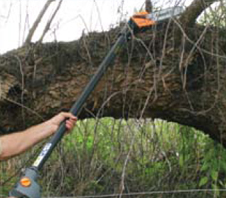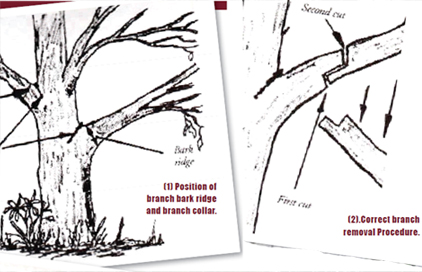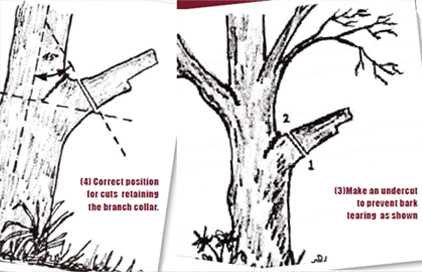 Hello all,
Hello all,
I trust work is still aplenty and I must say I am totally over the winter weather and look forward to the summer heat!
Well to follow on from the basics and maintenance issues regarding powered pole saws covered in the last issue, this month’s article continues to discuss pole saw operating techniques and branch removal.
One thing I have noticed on an increasingly alarming basis is the apparent lack of respect and maintenance of these machines. They all too often appear dirty with illegible warning stickers and a poorly maintained bar and chain.
I heard a great story the other day regarding a scenario that unfortunately seems all too common. It was about an amateur tree lopper who was observed using a powered pole saw to dismantle a rather large Poinciana in a private yard, cutting limbs that were evidently much too large for the capacity of the machine using the rip and tear method of removal. In the process he narrowly avoided falling off the short stepladder utilised to get that extra reach to cut the top limbs – almost crushed as they dropped as he stood directly under them. The end result was a couple of dents in the property roof and a smashed fence. The operator, who wore little if any PPE, managed to escape unscathed I believe.
OH&S and worksite planning
As with all operations carried out in the workplace, it is essential to conduct a risk assessment on site before any works start.
The control measures should include taking note of any worksite issues, emergency procedures, surroundings, exclusion zones, public access roads, and any other issues that may be raised during the assessment. There should be a plan of operation agreed upon and most importantly, communicate these items to all personnel on site.
At this stage I would strongly recommend the tree is taken into consideration and by this I mean; can the proposed operation be
carried out cleanly without tree damage using the pole saw?
Careless pruning leads to irreversible damage to the subject tree in the form of scars along the branches and coat hanger like stubs, large flush cuts, or wrongly angled branch collar pruning wounds. Operators must have at least some basic arboricultural knowledge and pruning skills.
Maintenance
Regular operator maintenance will ensure you continue to achieve maximum performance from your pole saw and should help to keep the pruning cuts in the correct position and cleanly finished. Maintenance of the bar and chain is the same as for the conventional chainsaw. So don’t neglect the maintenance duties, just make sure you use the correct chain tension file size and stick to the correct filing angles – as per the chain manufacturer’s recommendations.
Operation and Pruning
These machines are not insulated so unless you have the correct training, insulation, and certifi cation in electrical awareness, stay well away from overhead power lines. If in doubt call the local power supply company for advice.
Be aware of any legal and environmental restraints such as tree protection legislation and avoid disturbing any nesting birds or
wildlife.
Check the machine over prior to starting works and check that all safety features work correctly.
Wear the correct PPE which should consist of at least the following items:
- Head ear and eye protection.
- Gloves (anti-vibration if possible).
- Non snag outer clothing.
- Steel capped boots with a heavy tread pattern on the sole for grip.
- Chainsaw chaps or pants.

USING A POLE SAW CORRECTLY:
- It is recommended a safe working/exclusion zone of at least 15 metres is maintained around the machine while operating with bystanders prevented from entering this zone.
- Select a suitable site for fuelling and starting the machine as per the recommendations in the operator’s manual.
- Keep a fi rm footing and ensure the worksite is kept clear of fallen limbs and off cuts as work progresses.
- When planning to start cutting, you must correctly assess the tension and compression in the wood to avoid trapping the saw.
- Plan the sequence of operation and always reduce the weight of the branch gradually as you go by cutting it into manageable
sections. - Undercut the branch fi rst and ensure when making the top cut, that an overlap occurs to reduce the risk of tearing the
bark past the branch collar. - The resulting stub can be cut back cleanly to the branch collar.
- Make sure the hook on the underside is in contact with the branch to be cut at all times where possible.
- Always use the machine at an angle of less than 60 degrees from horizontal to reduce the risk of injury from falling
timber. - Make sure the fi nal cut is just on the outside edge of the branch collar.
Don’t forget the primary task powered pole saws are intended for is the removal of lateral branches. It is almost impossible to
make a correct pruning cut on upright growth and these normally result in a spear cut which will not be able to heal correctly.
It may also be useful to consider having a manually powered pole saw, such as a silky saw, for use in conjunction with the engine powered machine. This will allow for better positioning on some of the internal cuts that may need to be made around the canopy.

Don’t forget: pole saw and pruning certification.
The competency unit FPICOT3238A Operate a pole saw is a nationally recognised competency unit that covers use of these machines. The competency unit RTF2017A Prune shrubs and small trees complements the pole saw unit as it covers basic pruning practices. The two units are currently available as a two day course.
Trained and certifi cated operators have a greater understanding of pruning operations. The end result is usually seen in the
standard of pruning techniques and pole saw operation. Even regular operators can benefi t greatly from training and regular updates.
Book now for refresher training or to upgrade your skills with Training For Trees www.trainingfortrees.com.au


